| New World quail | |
|---|---|
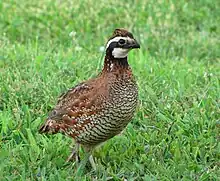 | |
| Northern bobwhite | |
| Scientific classification | |
| Domain: | Eukaryota |
| Kingdom: | Animalia |
| Phylum: | Chordata |
| Class: | Aves |
| Order: | Galliformes |
| Superfamily: | Phasianoidea |
| Family: | Odontophoridae Gould, 1844 |
| Genera | |
The New World quail are small birds, that despite their similar appearance and habits to the Old World quail, belong to a different family known as the Odontophoridae. In contrast, the Old World quail are in the Phasianidae family. The geographical range of the New World quail extends from Canada to southern Brazil, and two species, the California quail and the bobwhite quail, have been successfully introduced to New Zealand. The stone partridge and Nahan's partridge, both found in Africa, seem to belong to the family. Species are found across a variety of habitats from tropical rainforest to deserts, although few species are capable of surviving at very low temperatures. There are 34 species divided into 10 genera.
The legs of most New World quails are short but powerful, with some species having very thick legs for digging. They lack the spurs of many Old World galliformes. Although they are capable of short bursts of strong flight, New World quails prefer to walk, and run from danger (or hide), taking off explosively only as a last resort. Plumage varies from dull to spectacular, and many species have ornamental crests or plumes on their heads. Moderate sexual dichromism is seen in plumage, with males having brighter plumage.
Behaviour and ecology
The New World quails are shy diurnal birds and generally live on the ground; even the tree quails, which roost in high trees, generally feed mainly on the ground. They are generalists with regards to their diet, taking insects, seeds, vegetation, and tubers. Desert species in particular consume seeds frequently.
Most of the information about the breeding biology of New World quails comes from North American species, which have been better studied than those of the Neotropics. The family is generally thought to be monogamous, and nests are constructed on the ground. Clutch sizes are large, as is typical within the Galliformes, ranging from three to six eggs for the tree quail and wood quail, and as high as 10-15 for the northern bobwhite. Incubation takes between 16 and 30 days depending on the species. Chicks are precocial and quickly leave the nest to accompany the parents in large family groups.
Northern bobwhite and California quail are popular gamebirds, with many taken by hunters, but these species have also had their ranges increased to meet hunting demand and are not threatened. They are also artificially stocked. Some species are threatened by human activity, such as the bearded tree quail of Mexico, which is threatened by habitat loss and illegal hunting.
Species
Subspecies English names by Çınar 2015.[1]
| Subfamily | Image | Genus | Species |
|---|---|---|---|
| Ptilopachinae Bowie, Coehn & Crowe 2013 |  |
Ptilopachus Swainson 1837 |
|
| Odontophorinae Gould 1844 (New World quails) | Rhynchortyx Ogilvie-Grant 1893 |
| |
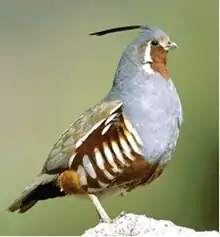 |
Oreortyx (Douglas 1829) Baird 1858 |
| |
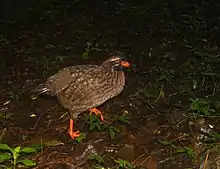 |
Dendrortyx Gould 1844 |
| |
.jpg.webp) |
Philortyx Gould 1846 non Des Murs 1854 |
| |
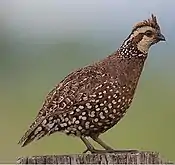 |
Colinus Goldfuss 1820 (Bobwhites) |
| |
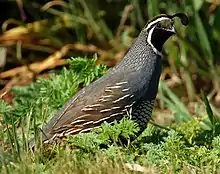 |
Callipepla Wagler 1832 (Crested quails) |
| |
_78_circulo_montana%252C_patagonia_lake_ranch_estates%252C_scc%252C_az_-01_(14805362757).jpg.webp) |
Cyrtonyx Gould 1844 |
| |
.jpg.webp) |
Dactylortyx (Gambel 1848) Ogilvie-Grant 1893 |
| |
.jpg.webp) |
Odontophorus Vieillot 1816 (wood quails) |
| |
Fossils
- Genus †Miortyx Miller 1944
- †Miortyx teres Miller 1944
- †Miortyx aldeni Howard 1966
- Genus †Nanortyx Weigel 1963
- †Nanortyx inexpectatus Weigel 1963
- Genus †Neortyx Holman 1961
- †Neortyx peninsularis Holman 1961
Phylogeny
Position within the Galliformes.
| |||||||||||||||||||||||||||||||||
| Phylogeny of the Galliformes based a study by De Chen and collaborators published in 2021.[2] The number of species are from the list maintained by Frank Gill, Pamela Rasmussen and David Donsker on behalf of the International Ornithologists' Union.[3] |
Living Odontophoridae based on the work by John Boyd.[4]
| ||||||||||||||||||||||||||||||||||||||||||||||||||||||||||||||||||||||||||||||||||||||||||||||||||||||||||||||||||||||||||||||||||||||||||||||||||||||||||||||||||||||||||||||||||||||||
See also
References
- ↑ Çınar, Ümüt (November 2015). "02 → Gᴀʟʟᴏᴀɴsᴇʀᴀᴇ : Gᴀʟʟɪfᴏʀᴍᴇs". English Names of Birds. Retrieved 30 December 2015.
- ↑ Chen, D.; Hosner, P.A.; Dittmann, D.L.; O’Neill, J.P.; Birks, S.M.; Braun, E.L.; Kimball, R.T. (2021). "Divergence time estimation of Galliformes based on the best gene shopping scheme of ultraconserved elements". BMC Ecology and Evolution. 21 (1): 209. doi:10.1186/s12862-021-01935-1. PMC 8609756. PMID 34809586.
- ↑ Gill, Frank; Donsker, David; Rasmussen, Pamela, eds. (July 2021). "Pheasants, partridges, francolins". IOC World Bird List Version 11.2. International Ornithologists' Union. Retrieved 23 November 2021.
- ↑ Boyd, John (2007). "Odontophoridae" (PDF). John Boyd's website. Retrieved 30 December 2015.
- del Hoyo, J.; Elliot, A. & Sargatal, J. (editors). (1994). Handbook of the Birds of the World. Volume 2: New World Vultures to Guineafowl. Lynx Edicions. ISBN 84-87334-15-6
External links
- gbwf.org - Quail, Aviculture & Conservation
- New World quail videos on the Internet Bird Collection